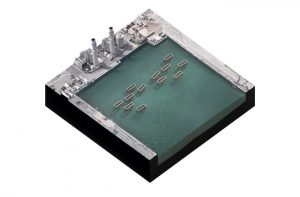How to use
A guideline for determining the feasibility and implementation of hanging and floating structures is presented below. In the pre-feasibility phase it is important to get insight in the physical boundary conditions and social-economic interests to determine the possibilities. In the feasibility phase the design is created in close collaboration between technicians and ecological experts. Field trials can be used to improve the design for area specific conditions. After this, the design can be constructed and monitored. Costs depend on the design, construction implications, maintenance and operational cost and benefits.
Pre-feasibility phase
Activities in the pre-feasibility phase are:
- Discussion with client on ecological and recreational potential in area of interest;
- Consideration of the possible interests involved in the area (creating new recreation areas, improving spatial quality, contributing to nature and climate goals, improving ecological value)
- Analysis of physical forcing factors and limiting design criteria as boundary criteria for application of hanginig and floating structures;
- Analysis of the physical aspects of the water system (flow and wave conditions, water depth, sediment characteristics, water quality [turbidity, light attenuation, dissolved oxygen, salinity, temperature], morphology)
- Analysis of local ecosystem biodiversity;
- Analysis of surrounding ecosystem and identification of possible interactions and reinforcements;
- Pre-design, valuation and costing of hanging and floating structures and presentation to the client;
- Selection of the most promising hanging/floating structure.
Feasibility phase
In the feasibility phase the following steps need to be taken:
- Technical design of most promising hanging/floating structure including planning and requirements:
- Determining location(s) for structures;
- Size of structures;
- Choice of materials;
- Seeding method (if required);
- Detailed costing and phasing within major project planning.
- Small-scale field trial to improve the design for the specific area
- Setup of monitoring and maintenance plans
- Considerations:
- Technical design should be created in interaction between technicians and ecologic experts to ensure optimum design for improving ecological value without increasing the number of invasive species.
In this phase the technical design is made. Field trials can be used to improve the design for the specific area.
Project phase
In the project phase the following steps need to be taken:
- Assessment of project implementation using technical and biological expertise;
- Execution of the project;
- Evaluation of ecological development over a period of several consecutive years (especially in case of a pilot).
Project costs
Project costs differ for different structures and locations.
Cost indication for a floating structure (2012) (buildingwithnatureinthecity.com):
Willow mattress measuring 20 x 5 metres tested for wave attenuation.
- Delivery and construction: EUR 6,500 including VAT;
- Planting with reed shoots: EUR 1,000 including VAT;
- Anchoring to the bed/embankment: EUR 11,000 including VAT;
- Total: EUR 18,500 = EUR 185/m 2).
This cost estimate does not include measures that need to be taken to ensure public safety.
For hula structures no cost indication is available. The material used is relatively cheap, but the hulas must be made by hand (buildingwithnatureinthecity.com).

